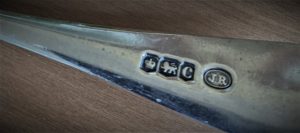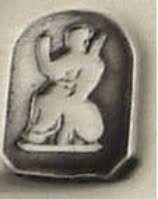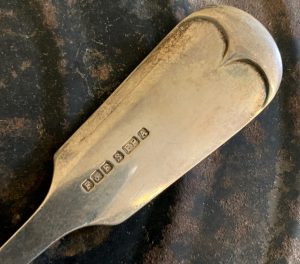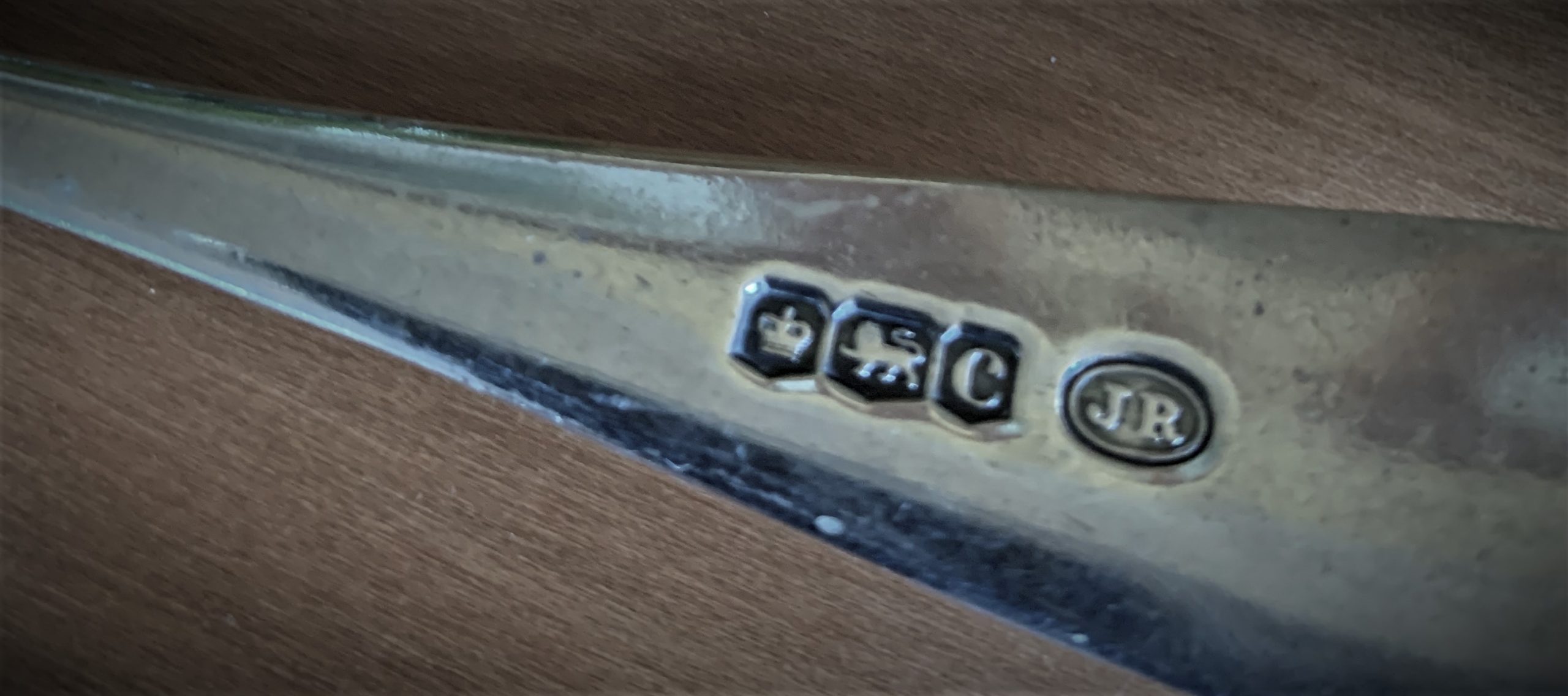Silver for domestic use is always an alloy, never pure.
What we casually call “silver” is never really silver in the pure sense, and there are different levels of silver content found in many different types of common silver objects. Most people mean “sterling” silver when they use the word generally. Luckily, sterling silver will almost always announce itself, but in different ways in different countries of origin.
The alloy of sterling has been strictly regulated in all English silver production for at least 700 years. The “lion passant” (a walking lion, second mark from the left on the spoon handle illustrated) indicates English sterling quality: 92.5% silver to 7.5% something else, usually copper.
sterling has been strictly regulated in all English silver production for at least 700 years. The “lion passant” (a walking lion, second mark from the left on the spoon handle illustrated) indicates English sterling quality: 92.5% silver to 7.5% something else, usually copper.
The alloy quality of silver outside of England will sometimes be indicated numerically: 925 for sterling, of course, but you might also see anything from 800 (usually German) to 9 58 (English Britannia standard), which was the quality for English silver enforced by law between 1697 and 1720, but it is still legal even today. In England, this higher silver content is indicated by the figure of Britannia in place of the sterling lion passant. Britannia standard is not very practical for everyday items because it is just too soft to withstand daily use.
58 (English Britannia standard), which was the quality for English silver enforced by law between 1697 and 1720, but it is still legal even today. In England, this higher silver content is indicated by the figure of Britannia in place of the sterling lion passant. Britannia standard is not very practical for everyday items because it is just too soft to withstand daily use.
The first silver production in the American Colonies obviously derived from the silversmithing practices of England, but for some reason, the precise, institutionalized system of assay and hallmarking never took hold in Colonial America or subsequently the United States, except for a brief time in Baltimore between 1814 and 1830.
Fine old American silver may be of two possible silver alloys: coin (89.2%-90% pure silver) and sterling (92.5%). Lacking a source of refined silver or the infrastructure necessary to produce it in-house, so to speak, silversmiths in the Colonies relied on recycling to obtain their raw material, melting down Spanish coins or existing English sterling items that they or their customers may have had on hand. In either case, the silver content of American silver will usually be spelled out on it: sterling or coin. I say “usually” because there’s a lot of silver out there that’s inexplicably unmarked.
In the absence of any marks at all, regardless of its place of origin, the quality of the silver cannot be determined by the naked eye. Sometimes the marks on sterling silver can be rubbed off, so you don’t want to automatically assume an unmarked piece is not sterling. On the other hand, one should never represent silver as sterling without some evidence that it really is of that quality. When confronted with a totally unmarked piece of silver about which you know nothing else, you could test it, but this process involves acids and scraping samples off the suspect piece, both of which introduce a measure of danger I am rarely eager to face. In my opinion, the acid test is only worth the risk in cases where I am confident, based on other evidence, that the legitimate valuation of the item depends on identification.
The Scoop on Silverplate
The spot price of sterling silver has been pretty steady in recent years, hovering around $25 per Troy ounce, so sterling silver objects always retain some value. Silverplate, on the other hand, has precious little precious metal on it, so the value of silverplated ware is purely decorative and utilitarian. Luckily, plated ware is easy to distinguish from sterling silver if you know how to read the marks.
A great many plated items will be marked with some version of EPNS, which stands for “electroplated nickel silver.” As a base metal, nickel has the advantage of b eing a “silvery” metal itself, unlike the distinctively reddish hue of copper, so even if the plating is completely worn away (which can happen), the article will still look “silver” to the eye.
eing a “silvery” metal itself, unlike the distinctively reddish hue of copper, so even if the plating is completely worn away (which can happen), the article will still look “silver” to the eye.
Other common marks to look for on silverplate are “EP” (as shown in the oblong mark second from the right on this fiddle-style spoon), “SP,” “SP copper,” or the words “double,” “triple,” “quadruple,” or “soldered.”
Unlike sterling, there is no inherent value to silverplate, so the only thing to do is enjoy it!

